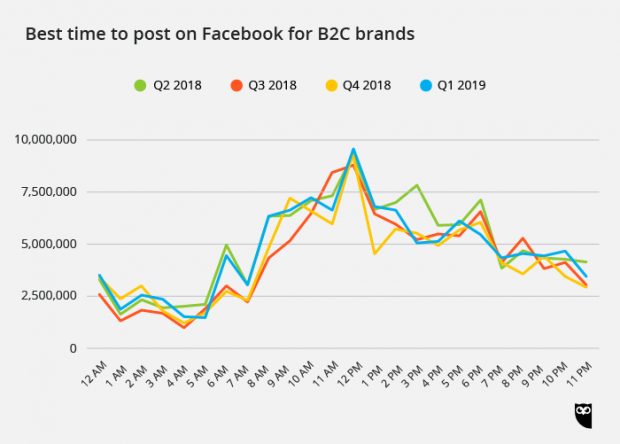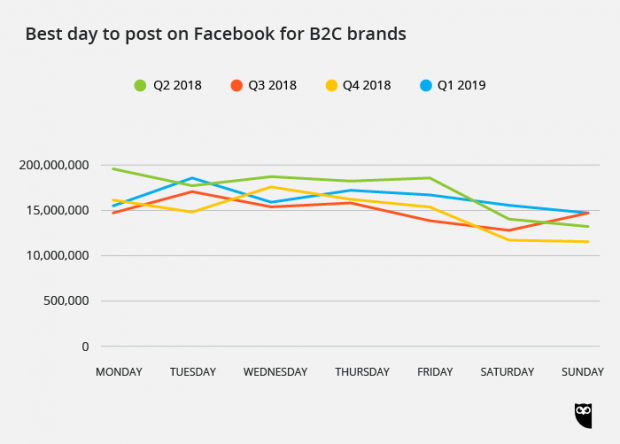Continue to find out Facebook marketing in 2020…
How to create a 2020 Facebook marketing strategy in 7 simple steps
Now that you perceive the different sorts of Facebook posts, let’s take a look at some Facebook marketing ideas in 2020 that can assist you to construct a solid technique for this powerful social tool.
1. Define your audience
To have interaction with your audience successfully, you need to first understand who your target audience is.
Ask yourself the next questions:
- How previous are your target followers?
- Where do they live?
- What sort of jobs have they got?
- What are their challenges and pain points?
- How and when do they use Facebook?
To start out, ensure you understand the basic Facebook demographics. When you know who uses the platform and the way that maps back to your target customer, check out Facebook Audience Insights.
Use Audience Insights to drill down into the nitty-gritty particulars about potential clients. You can use this tool to find information on issues like:
- Age
- Gender
- Education
- Relationship status
- Location
- Language
- Facebook utilization
- Past buying activity
This is one of the most necessary Facebook marketing ideas for utilizing the platform efficiently: Always have a clear thought of precisely who you are trying to reach.
2. Set goals for Facebook marketing
It may be tempting to focus on vanity metrics, like racking up Likes. However, except these Likes are part of a broader marketing plan, they’re not going to offer an awesome return.
For your Facebook marketing technique to be efficient, you’ve obtained to have clear objectives tied to real business aims.
The goals will differ for every business, however, they need to all focus on actions that have a real effect in your bottom line. For instance:
- generating leads
- growing conversions on your website
- improving customer support.
These broad categories are a great place to start out. Next, you should make your objectives much more specific and measurable. Here, we recommend utilizing a recognized goal-setting framework like S.M.A.R.T. objectives or the O.K.R. aim framework.
We clarify both of those goal-setting methods, along with examples of how they work in observe, in our post on social media goal-setting.
Everything you do on Facebook—every post, comment, and ad—ought to work to help your objectives. To keep issues on track, it’s a good idea to distill your technique down into a Facebook mission statement on your brand.
Having a clear image of your objectives will also assist you to craft an efficient Facebook-style guide on your brand. It will ensure you keep a consistent brand voice that works to help the objectives you select.
3. Plan your content mix
When you’ve set your objectives, you should create a plan for the way to obtain them.
A key part of that plan is figuring out the right content mix. We recommend beginning with either the 80-20 rule or the social media rule of thirds.
In case you follow the 80-20 rule:
- use 80% of your Facebook posts to inform, educate, and entertain
- Use the other 20% to promote your brand
Keep in mind that utilizing Facebook for business is all about constructing relationships, and self-promotion isn’t a good way to do that. However, in case you present enough value, your viewers might be open to learning about your services in the 20 percent of posts that are more sales-focused.
The social media rule of thirds additionally prescribes a great mix of useful content vs. promotional posts:
- one-third of your content ought to share concepts and stories
- one-third ought to involve private interactions with your followers
- the remaining third can promote your business
The aim is to offer more value than promotional materials to maintain followers engaged.
Facebook’s algorithm will always penalize brands that push sales too hard. Facebook needs its customers’ news feeds to be filled with content they want to Like and share.
As a marketer, you need to want that too. All these Likes and shares assist prolong your attain and put your brand in front of new eyeballs.
The final part of planning your content mix is to find out when and the way usually to post.
This will take some trial and error (utilizing engagement data gleaned from Page Insights). However, analysis typically reveals that the best time to post on Facebook is:
- For B2B brands: between 9 a.m. and 2 p.m. EST on Tuesday, Wednesday, or Thursday.
- For B2C brands: 12 p.m. EST on Monday, Tuesday, or Wednesday
It’s necessary to post persistently. Create a content calendar to assist balance your mixture of content sorts and maintain your posting schedule on track. We’ve created a free content calendar template you should use. The Hootsuite Planner is another nice useful resource that can assist you to plan and handle your Facebook content combine.
For more strategic planning concepts, take a look at our post on how to create a social media marketing plan.
4. Optimize your Page for engagement
In order to obtain the 2020 Facebook marketing objectives you set in Step no. 2, you should make it simple for individuals to find your Facebook Page. And you should compel them to Like your Page once they get there.
Begin by ensuring your Facebook Business Page is absolutely optimized for success, as defined in this video:
Tip: Put some further effort into your Facebook Page cover image, because it’s the first thing individuals will see once they go to your Page.
Next, it’s time to get these views, Likes, and Follows rolling in.
First, make it simple for individuals you already interact with on other channels to search out your Facebook Page:
- Link to your Page in your email signature, newsletter, and different channels
- Incorporate Facebook Like and share buttons on your website and blog to make it simple for individuals to find, follow, and share your Page in a single click
After all, if you’d like individuals to share your content, you should ensure that the content you post to Facebook is extremely shareable. Creating useful and entertaining content that followers might be happy to share with their connections is one of the best ways to expand your organic reach.
It bears repeating here that Facebook is a social community. In case you’re not engaged with your Page, why ought to your followers be? Followers who discover themselves talking into a void will abandon your Page for more responsive brands.
Your mantra is reply, reply, reply. Reply to each message and comment. Answer questions.
Lastly, ensure that your Page stays up to date. Schedule a regular audit of your Facebook Page to check for and remove any outdated content. Ensure your About section is accurate, up-to-date, and on-brand.



